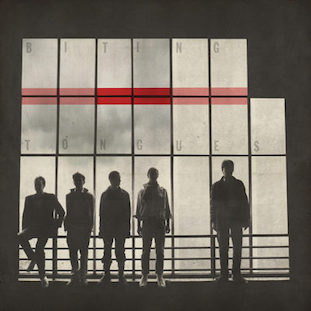5 Dec 2019
The Biting Tongues 'Live It' Review by Iain Key
Former Factory artist Biting Tongues have just had their 1981 limited cassette-only lost release 'Live It' reissued by Andy Votel's Finders Keepers Records.
Originally released on New Hormones, Biting Tongues' 2nd album was one of a series of three limited edition releases of just 500 cassettes (others by Ludus and CP Lee) that came with a booklet, badge, stickers and a sweatshirt offer. The 6-track release has now been expanded to 10 with the additional 4 tracks coming from rare cassette magazines released at the time.
The idea of releasing it on tape only appears to have been a financial one by the label despite them being in vogue (the Walkman being relatively new and cassette sales actually being equal to, if not greater than vinyl at the time). In his notes, Graham Massey explains, "New Hormones didn't have enough money to press it up on vinyl and so it became a cassette-only release, which felt like a bit of a disappointment. I always felt it buried some of our best work, compounded by the fact that we actually left off some of the best tracks from the session. These tracks lived on a cassette I've carried around for forty years, the tape slowly getting dull and wearing thin. In recent years I've been digitising Colin Seddon's cassette collection of Biting Tongues material and rediscovered a first-generation recording of the sessions on TDK SA tape."
Prior to listening to this reissue of 'Live It' I'd only previously only heard a handful tracks released on various Factory compilations and only had a very rough idea of the history of the band from their formation to provide a soundtrack to the saxophonist Howard Walmsley's film 'Biting Tongues' through to the initially unreleased 'Recharge' album so it was fascinating listening to this as a something new in 2019 and also trying to imagine how it would have fit in during those heady days of post-punk and New Romantics.
My thoughts on the first couple of listens were that it was very angular and abstract, not very easy listening, and improvised. Through Graham's notes which accompany this release it would appear my final thought especially was wide of the mark, with several mentions of demos being recorded and sent down to London for vocalist Ken Hollings to refine his lyrics before travelling up to Manchester to record them.
So improvised may be the wrong word; with repeated listens there is clearly a depth and structure to the tracks despite it occasionally sounding like band members are going off and playing at tangents with vocals being improvised. As Ken explained in an interview in 2008 there is a difference to how the band would record which gives it a unique sound and one was that odds with how many things would have been produced at the time, "We'd record a whole side of an album in one session with no breaks between the tracks and do a mix afterwards – nothing was ever re-recorded – we'd even leave in any slips of the tongue or mispronounced words I might have struggled with in the session, any stray pieces of sound that the microphone picked up, or we'd simply record straight onto two-channel tape, recording through the studio desk with the producer mixing and adding effects while we were performing in the studio – we wouldn't know what it sounded like until the playback – and because it was two-channel you couldn't correct it: you'd have to do the whole thing again, which we pretty much refused to do'.
I can hear some influences on this release from Talking Heads' 1980 release 'Remain In Light' but, for those listening in 1981, tracks such as 'Libreville' would have easily complemented releases such as 'To Each...' by A Certain Ratio where tracks such as 'Back To The Start' mix a variety of instruments, not always conventional over driving rhythms to create a danceable beat, but very different to the polished chart music at the time which was dominated by the likes of Adam and The Ants, Madness and Soft Cell.
In 2019 each listen brings something new, there is so much going on across the 10 tracks there's a sense of opening Pandora's Box that it begs for repeated listening, and although it maybe a little challenging at, first patience is paid off.
It's not often that something that's nearly 40 years old can sound as contemporary, interesting and challenging as this release does.
Labels: album, Biting_Tongues, Iain_Key, review
- - - -
Popular posts
Use Hearing Protection - Factory Records 1978-1979
Use Hearing Protection Factory Records 1978-1979 review
Hacienda How Not to Run a Club TV series
Use Hearing Protection - Fac 1-50 / 40 exhibition
Out of Order - Curating the Factory Catalogue
The Drifting Cowboys Durutti Column T-Shirt
Latest posts
Latest pages
- Electronic Sound magazine [Issue 54] Factory Records
- May 1980 release schedule
- hallowed articles
- FAC 148
- FAC 148 letter from Quarry Bank Mill to Tony Wilson
- FAC 81 stationery source materials
- FAC 81 stationery
- 86 Palatine Road Blue Plaque
- Joy Divison USA Tour Itinerary
- Tony Wilson letter to Ralph Steadman re John Dowie
- IKON stationery
- The Factory stationery
- In the City badge
- Peter Saville Associates stationery and bill
- Movement of the 24th January stationery



































<< Home